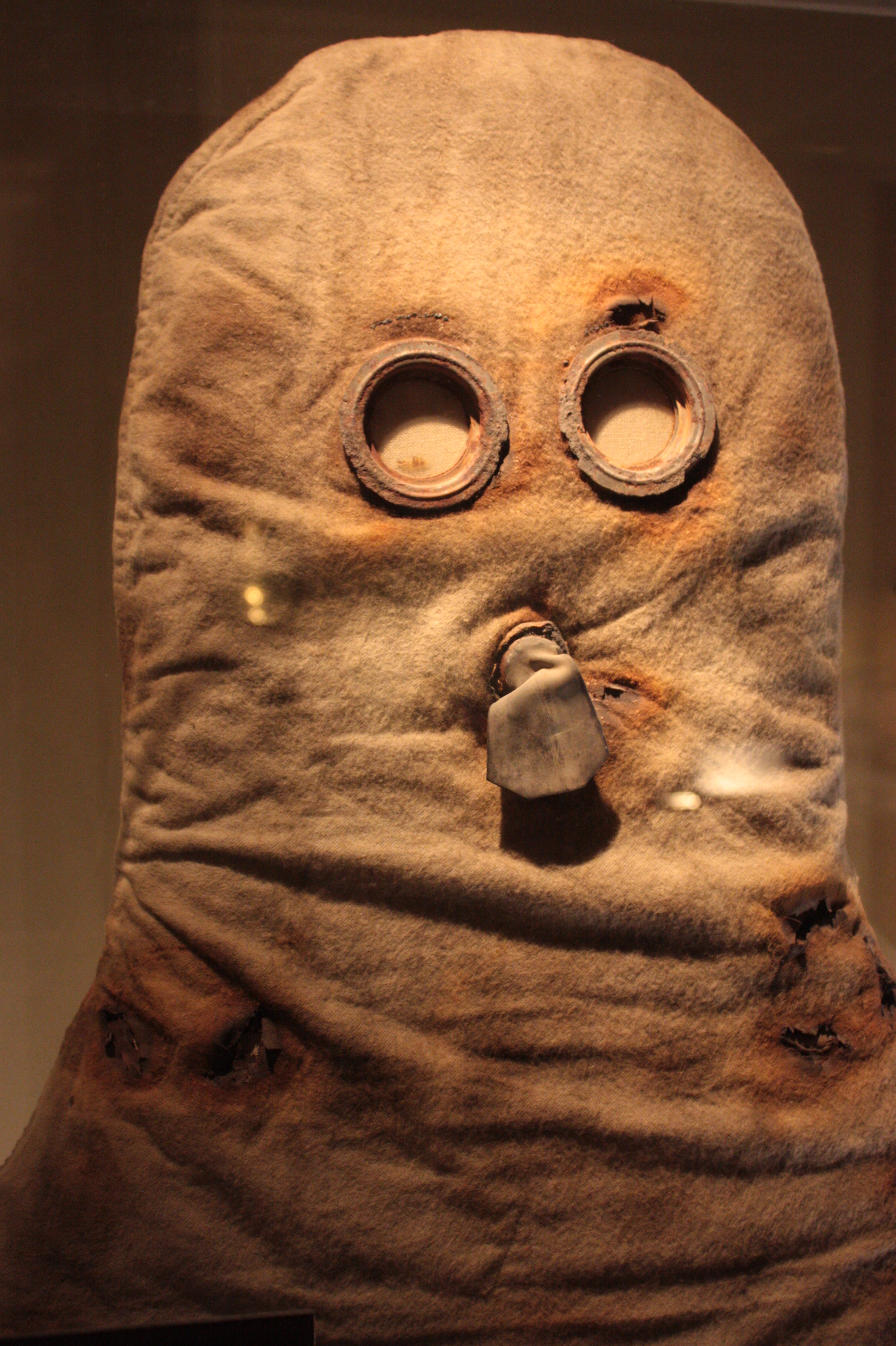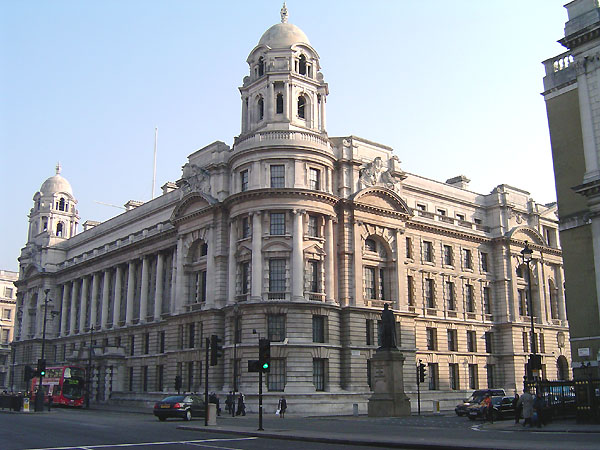|
Hypo Helmet
The Hypo helmet, or British Smoke Hood (its official name), was an early British World War I gas mask, designed by Cluny Macpherson. Background The German army used poison gas, in the form of chlorine, for the first time against Triple Entente troops at the Second Battle of Ypres, Belgium, on 22 April 1915. The British began issuing cotton wool wrapped in muslin to its troops by 3 May. This was followed by the Black Veil Respirator, invented by John Scott Haldane, which began to be issued to troops on 20 May 1915. The Black Veil was a cotton pad soaked in an absorbent solution which was secured over the mouth using black cotton veiling. The veiling could be drawn up to cover the eyes, providing some protection against lachrymatory agents but the mask still provided little protection against chlorine gas. It was also of fragile construction, required training to use and largely immobilised men during a gas attack as they were concerned about their mask coming loose. Design Seek ... [...More Info...] [...Related Items...] OR: [Wikipedia] [Google] [Baidu] |
Gas Mask
A gas mask is a piece of personal protective equipment used to protect the wearer from inhaling airborne pollutants and toxic gases. The mask forms a sealed cover over the nose and mouth, but may also cover the eyes and other vulnerable soft tissues of the face. Most gas masks are also respirators, though the word ''gas mask'' is often used to refer to military equipment (such as a field protective mask), the scope used in this article. Gas masks only protect the user from ingesting or inhaling chemical agents, as well as preventing contact with the user's eyes (many chemical agents affect through eye contact). Most combined gas mask filters will last around 8 hours in a biological or chemical situation. Filters against specific chemical agents can last up to 20 hours. Airborne toxic materials may be gaseous (for example, chlorine or mustard gas), or particulates (such as biological warfare, biological agents). Many filters provide protection from both types. The first gas m ... [...More Info...] [...Related Items...] OR: [Wikipedia] [Google] [Baidu] |
War Office
The War Office has referred to several British government organisations throughout history, all relating to the army. It was a department of the British Government responsible for the administration of the British Army between 1857 and 1964, at which point its functions were transferred to the new Ministry of Defence (United Kingdom), Ministry of Defence (MoD). This article contains text from this source, which is available under th Open Government Licence v3.0 © Crown copyright It was equivalent to the Admiralty (United Kingdom), Admiralty at that time, which was responsible for the Royal Navy (RN), and (much later) the Air Ministry, which oversaw the Royal Air Force (RAF). The name 'Old War Office' is also given to the former home of the department, located at the junction of Horse Guards Avenue and Whitehall in central London. The landmark building was sold on 1 March 2016 by HM Government for more than British pound, £350 million, on a 250-year lease for conversion int ... [...More Info...] [...Related Items...] OR: [Wikipedia] [Google] [Baidu] |
Chloropicrin
Chloropicrin, also known as PS (from Port Sunlight) and nitrochloroform, is a chemical compound currently used as a broad-spectrum antimicrobial, fungicide, herbicide, insecticide, and nematicide. It was used as a poison gas in World War I and the Russian military has been accused of using it in the Russo-Ukrainian War. Its chemical structural formula is . Synthesis Chloropicrin was discovered in 1848 by Scottish chemist John Stenhouse. He prepared it by the reaction of sodium hypochlorite with picric acid: Because of the precursor used, Stenhouse named the compound chloropicrin, although the two compounds are structurally dissimilar. Today, chloropicrin is manufactured by the reaction of nitromethane with sodium hypochlorite: Reaction of chloroform and nitric acid also yields chloropicrin: Properties Chloropicrin's chemical formula is and its molecular weight is 164.38 grams/mole. Pure chloropicrin is a colorless liquid, with a boiling point of 112 °C. Chloropicri ... [...More Info...] [...Related Items...] OR: [Wikipedia] [Google] [Baidu] |
Diphosgene
Diphosgene is an organic chemical compound with the formula ClCO2CCl3. This colorless liquid is a valuable reagent in the synthesis of organic compounds. Diphosgene is related to phosgene and has comparable toxicity, but is more conveniently handled because it is a liquid, whereas phosgene is a gas. Production and uses Diphosgene is prepared by radical chlorination of methyl chloroformate under UV light: :Cl-CO-OCH3 + 3 Cl2 —(hv)→ Cl-CO-OCCl3 + 3 HCl Another method is the radical chlorination of methyl formate: :H-CO-OCH3 + 4 Cl2 —(hv)→ Cl-CO-OCCl3 + 4 HCl Diphosgene converts to phosgene upon heating or upon catalysis with charcoal. It is thus useful for reactions traditionally relying on phosgene. For example, it convert amines into isocyanates, secondary amines into carbamoyl chlorides, carboxylic acids into acid chlorides, and formamides into isocyanides. Diphosgene serves as a source of two equivalents of phosgene: :2 RNH2 + ClCO2CCl3 → 2 RNCO + 4 HC ... [...More Info...] [...Related Items...] OR: [Wikipedia] [Google] [Baidu] |
Phosgene
Phosgene is an organic chemical compound with the formula . It is a toxic, colorless gas; in low concentrations, its musty odor resembles that of freshly cut hay or grass. It can be thought of chemically as the double acyl chloride analog of carbonic acid, or structurally as formaldehyde with the hydrogen atoms replaced by chlorine atoms. In 2013, about 75–80 % of global phosgene was consumed for isocyanates, 18% for polycarbonates and about 5% for other fine chemicals. Phosgene is extremely poisonous and was used as a chemical weapon during World War I, where it was responsible for 85,000 deaths. It is a highly potent pulmonary irritant and quickly filled enemy trenches due to it being a heavy gas. It is classified as a Schedule 3 substance under the Chemical Weapons Convention. In addition to its industrial production, small amounts occur from the breakdown and the combustion of organochlorine compounds, such as chloroform. Structure and basic properties Phosgene ... [...More Info...] [...Related Items...] OR: [Wikipedia] [Google] [Baidu] |
PH Helmet
The P helmet, PH helmet and PHG helmet were early types of gas mask issued by the British Army in the First World War, to protect troops against chlorine, phosgene and tear gases. Rather than having a separate filter for removing the toxic chemicals, they consisted of a gas-permeable hood worn over the head which was treated with chemicals. The P (or Phenate) Helmet, officially called the Tube Helmet, appeared in July 1915, replacing the simpler Hypo Helmet. It featured two mica eyepieces instead of the single visor of its predecessor, and added an exhale valve fed from a metal tube which the wearer held in his mouth. The exhale valve was needed because a double layer of flannel – one treated and one not – was needed because the solution attacked the fabric. It had flannel layers of cloth-dipped in sodium phenolate and glycerin and protected against chlorine and phosgene, but not against tear gas. Around 9 million were made. The PH Helmet (Phenate Hexamine) replaced it ... [...More Info...] [...Related Items...] OR: [Wikipedia] [Google] [Baidu] |
Sorbent
A sorbent is an insoluble material that either absorbs or adsorbs liquids or gases. They are frequently used to remove pollutants and in the cleanup of chemical accidents and oil spills. Besides their uses in industry, sorbents are used in commercial products such as diapers and odor absorbents, and are researched for applications in environmental air analysis, particularly in the analysis of volatile organic compounds. The name sorbent is derived from sorption, which is itself a derivation from adsorption and absorption. Mechanism of action Sorbents collect specific liquids or gases depending on the composition of the material being used in the sorbent. Some of the most common sorbents used to clean oil spills are made from materials that are both oleophilic and hydrophobic, have high surface area through structural designs that include pores and capillaries, and draw in liquid through capillary action. Sorbents may be used to collect undesirable ions and act like a reusa ... [...More Info...] [...Related Items...] OR: [Wikipedia] [Google] [Baidu] |
Sodium Thiosulphate
Sodium thiosulfate (sodium thiosulphate) is an inorganic compound with the formula . Typically it is available as the white or colorless pentahydrate (x = 5), which is a white solid that dissolves well in water. The compound is a reducing agent and a ligand, and these properties underpin its applications. Uses Sodium thiosulfate is used predominantly in dyeing. It converts some dyes to their soluble colorless "leuco" forms. It is also used to bleach "wool, cotton, silk, ...soaps, glues, clay, sand, bauxite, and... edible oils, edible fats, and gelatin." Medical uses Sodium thiosulfate is used in the treatment of cyanide poisoning. It is on the World Health Organization's List of Essential Medicines. Other uses include topical treatment of ringworm and tinea versicolor, and treating some side effects of hemodialysis and chemotherapy. In September 2022, the U.S. Food and Drug Administration (FDA) approved sodium thiosulfate under the trade name Pedmark to lessen the risk of ... [...More Info...] [...Related Items...] OR: [Wikipedia] [Google] [Baidu] |
Glycerin
Glycerol () is a simple triol compound. It is a colorless, odorless, sweet-tasting, viscous liquid. The glycerol backbone is found in lipids known as glycerides. It is also widely used as a sweetener in the food industry and as a humectant in pharmaceutical formulations. Because of its three hydroxyl groups, glycerol is miscible with water and is Hygroscopy, hygroscopic in nature. Modern use of the word glycerine (alternatively spelled glycerin) refers to commercial preparations of less than 100% purity, typically 95% glycerol. Structure Although chirality, achiral, glycerol is prochirality, prochiral with respect to reactions of one of the two primary alcohols. Thus, in substituted derivatives, the Glycerophospholipid#Nomenclature and stereochemistry, stereospecific numbering labels the molecule with a ''sn''- prefix before the stem name of the molecule. Production Natural sources Glycerol is generally obtained from plant and animal sources where it occurs in triglycerides, est ... [...More Info...] [...Related Items...] OR: [Wikipedia] [Google] [Baidu] |
Flannel
Flannel is a soft woven fabric, of varying fineness. Flannel was originally made from carded wool or worsted yarn, but is now often made from either wool, cotton, or synthetic fiber. Flannel is commonly used to make tartan clothing, blankets, bed sheets, sleepwear, and several other uses. Flannel may be brushed to create extra softness or remain unbrushed. Brushing is a mechanical process wherein a fine metal brush rubs the fabric to raise fine fibres from the loosely spun yarns to form a nap on one or both sides. If the flannel is not napped, it gains its softness through the loosely spun yarn in its woven form. The term "flannel shirt" is often mistakenly used to refer to any shirt with a plaid or tartan pattern. However, 'flannel' refers simply to the fabric; not all flannel shirts are plaid and not all plaid shirts are flannel. History The word's origin is uncertain, but a Welsh origin has been suggested as fabric similar to flannel can be traced back to Wales, where ... [...More Info...] [...Related Items...] OR: [Wikipedia] [Google] [Baidu] |
Khaki
The color khaki (, ) is a light shade of tan (color), tan with a slight yellowish tinge. Khaki has been used by many armies around the world for uniforms and equipment, particularly in arid or desert regions, where it provides camouflage relative to sandy or dusty terrain. It has been used as a color name in English since 1848 when it was introduced as a military uniform.Maerz and Paul ''A Dictionary of Color'' New York:1930 McGraw-Hill Page 197; Color Sample of Khaki: Page 49 Plate 13 Color Sample J7 In Western fashion, it is a standard color for smart casual dress trousers for civilians, which are also often called ''khakis''. In British English and some other Commonwealth usage, ''khaki'' may also refer to a shade of green known as Olive (color)#Olive_drab, olive drab. Etymology ''Khaki'' is a loanword from Urdu wikt:خاکی, خاکی 'soil-colored', which in turn comes from Persian language, Persian wikt:خاک, خاک ''khāk'' 'soil' + (adjectival attributive suffi ... [...More Info...] [...Related Items...] OR: [Wikipedia] [Google] [Baidu] |





